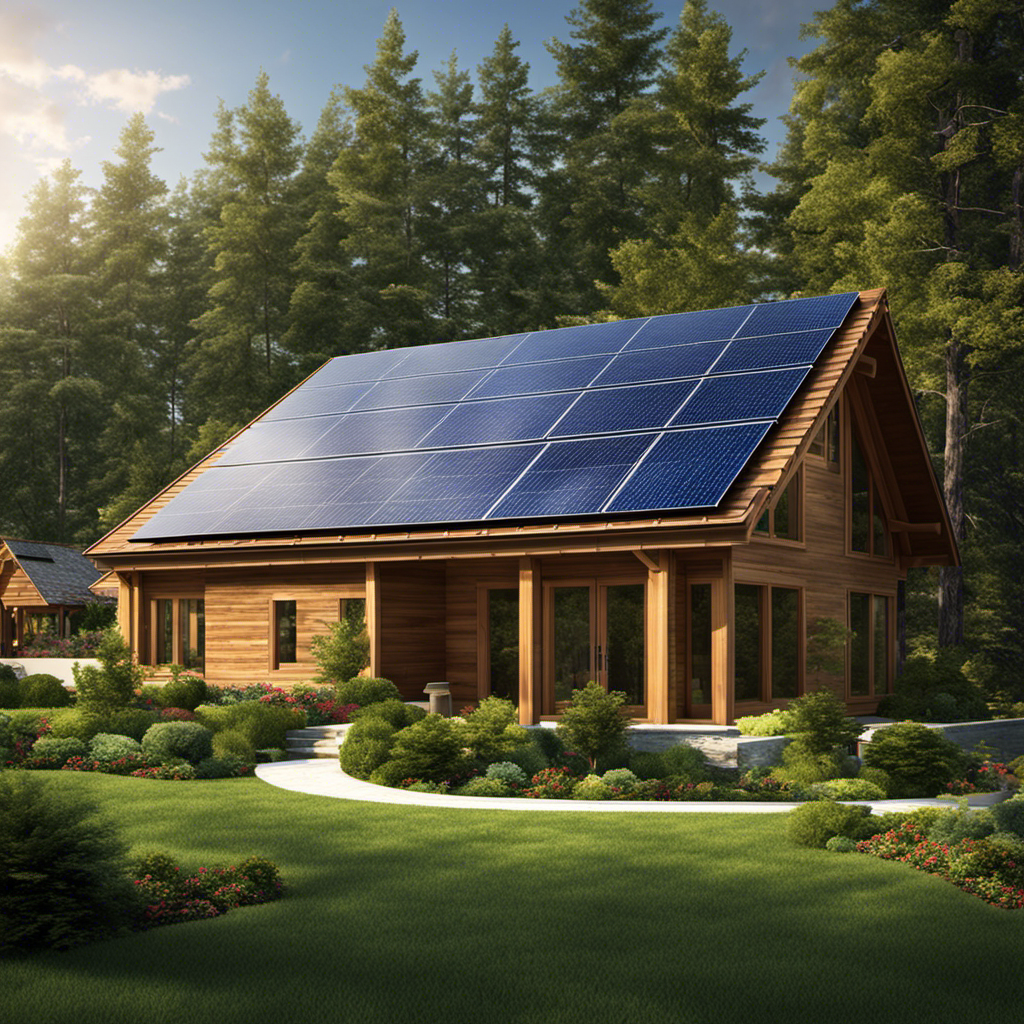Local Vs. National Transitions: the Differences in Scaling Renewable Energy
I understand that some may question the differences between local and national transitions when it comes to scaling renewable energy. However, as I will demonstrate in this article, there are distinct advantages and challenges associated with each approach.
By examining the importance of local initiatives, national strategies, decentralized energy production, government incentives, financial considerations, collaboration between entities, technology adaptation, and evaluating environmental impact, we can gain a comprehensive understanding of how these transitions differ and how they contribute to the overall goal of achieving sustainable energy systems.
Key Takeaways
- Local initiatives play a crucial role in scaling renewable energy by receiving government support and financial incentives.
- National strategies are important for efficient resource allocation, large-scale projects, policy harmonization, and attracting investments in renewable energy.
- Decentralized energy production at the local level empowers communities, reduces reliance on centralized utilities, and promotes local economic development.
- Government incentives such as tax credits, feed-in tariffs, and grant programs encourage the adoption of renewable energy at the local level and make projects more affordable.
The Importance of Local Initiatives
You need to understand the importance of local initiatives in scaling renewable energy. Government support and community participation are two key factors that drive the success of these initiatives.
Local governments play a crucial role in providing the necessary support and resources to promote the adoption of renewable energy technologies at the community level. They can offer financial incentives, such as tax breaks or grants, to encourage individuals and businesses to invest in renewable energy systems. Additionally, local governments can streamline bureaucratic processes and provide technical expertise to facilitate the implementation of renewable energy projects.
Community participation is equally important in scaling renewable energy. When residents actively engage in the decision-making process and take ownership of renewable energy projects, the chances of success increase significantly. By involving the community, local initiatives can tap into local knowledge and resources, leading to more effective and sustainable solutions. Community participation also fosters a sense of collective responsibility and ownership, which can further drive the adoption of renewable energy technologies.
National Strategies for Renewable Energy Scaling
When it comes to expanding renewable energy, it’s important to consider the strategies implemented at a national level. National strategies play a crucial role in scaling up renewable energy and achieving sustainable development goals. Here are three key reasons why national strategies are essential in this endeavor:
-
Efficiency: National strategies allow for a coordinated approach to renewable energy deployment across the country. This ensures maximum efficiency in resource allocation and reduces duplication of efforts. By centralizing decision-making, governments can streamline processes, accelerate project implementation, and optimize the use of available resources.
-
Economies of scale: National strategies enable the development of large-scale renewable energy projects. These projects benefit from economies of scale, resulting in lower costs per unit of energy produced. Moreover, a national approach facilitates the integration of different renewable energy sources, such as solar, wind, and hydro, to create a diversified and resilient energy mix.
-
Policy harmonization: National strategies provide an opportunity to harmonize renewable energy policies and regulations across regions. This alignment fosters a consistent and stable investment environment, attracting both domestic and foreign investments. It also promotes knowledge sharing and collaboration among different stakeholders, driving innovation and technological advancements in the renewable energy sector.
Decentralized Energy Production at the Local Level
At the community level, embracing decentralized energy production allows for greater control over energy sources and consumption. Decentralized energy management empowers communities to take charge of their energy needs, reducing reliance on centralized utilities and promoting sustainability. By generating energy locally, communities can tap into renewable sources such as solar, wind, and biomass, minimizing carbon emissions and contributing to a cleaner environment.
To illustrate the benefits of decentralized energy production, let’s consider a comparison between centralized and decentralized energy systems:
| Centralized Energy System | Decentralized Energy System |
|---|---|
| Reliant on large-scale power plants | Relies on distributed energy sources |
| Vulnerable to grid failures | Less prone to blackouts or grid failures |
| Limited consumer control | Gives consumers greater control over energy production and consumption |
| High transmission losses | Minimizes transmission losses due to shorter distances |
As the table demonstrates, decentralized energy production offers numerous advantages over centralized systems. Not only does it enable communities to become more self-reliant, but it also promotes local economic development through job creation in the renewable energy sector.
Government Incentives for Local Renewable Energy Projects
If you’re interested in government incentives, it’s worth exploring the various programs available for supporting local renewable energy projects. These initiatives aim to encourage the adoption of renewable energy sources at the local level and provide financial support and incentives to individuals, businesses, and communities.
Here are three examples of government support and local incentives for renewable energy projects:
-
Tax credits: Many governments offer tax credits to individuals and businesses that invest in renewable energy technologies such as solar panels or wind turbines. These credits can significantly reduce the upfront costs and make renewable energy installations more affordable.
-
Feed-in tariffs: Some regions have implemented feed-in tariff programs, which guarantee a fixed payment for the electricity generated by renewable energy systems. This provides a stable income for renewable energy producers and incentivizes the development of local renewable projects.
-
Grant programs: Governments often offer grants to support the development and implementation of local renewable energy projects. These grants can provide funding for feasibility studies, equipment purchases, and installation costs, making it easier for communities and businesses to embark on renewable energy initiatives.
These government incentives play a crucial role in driving the adoption of renewable energy at the local level. However, scaling renewable energy nationally poses significant challenges that need to be addressed.
Challenges in Scaling Renewable Energy Nationally
Scaling renewable energy nationally presents a myriad of challenges. Particularly, there are regulatory hurdles and grid integration issues. From a regulatory standpoint, navigating complex and sometimes conflicting policies and regulations can pose significant obstacles for renewable energy developers and investors.
Additionally, integrating renewable energy into the existing grid infrastructure requires careful planning and coordination to ensure stability and reliability. These challenges must be addressed in order to effectively scale renewable energy and achieve a sustainable and low-carbon future.
Regulatory Hurdles for Scaling
The regulatory hurdles for scaling renewable energy can be difficult to navigate at the local and national levels. As a renewable energy developer, I have encountered numerous challenges when it comes to policy implementation and overcoming regulatory barriers. Here are three key reasons why these hurdles can be so daunting:
-
Complex Permitting Processes: Obtaining the necessary permits and approvals for renewable energy projects can be a lengthy and cumbersome process. Local and national regulations often vary, making it difficult to navigate and comply with all the requirements.
-
Lack of Consistent Policies: Inconsistent policies across different jurisdictions create uncertainty for renewable energy developers. Varying rules and regulations make it challenging to plan and invest in projects effectively.
-
Interference from Fossil Fuel Interests: The influence of fossil fuel interests can pose a significant roadblock to scaling renewable energy. Lobbying efforts and political pressure can hinder the implementation of supportive policies and slow down the transition to clean energy.
Overcoming these regulatory hurdles requires collaboration between government bodies, industry stakeholders, and communities to streamline processes, establish consistent policies, and prioritize the long-term benefits of renewable energy.
Grid Integration Challenges
Navigating the complex and varying regulations around grid integration can be a challenge for renewable energy developers. Ensuring grid reliability while integrating a significant amount of renewable energy into the existing infrastructure requires careful planning and coordination.
One key aspect of grid integration is renewable energy storage. As renewable energy sources such as solar and wind are intermittent, it is crucial to have storage systems in place to balance supply and demand and ensure grid stability. Storage technologies like batteries and pumped hydro can help store excess renewable energy during times of high generation and release it when needed. These storage solutions contribute to grid reliability by providing a stable and continuous power supply.
Transitioning into the next section about community engagement in local renewable energy transitions, it is important to involve stakeholders in the decision-making process to ensure a successful and inclusive transition.
Community Engagement in Local Renewable Energy Transitions
In discussing the importance of local involvement and overcoming community resistance in renewable energy transitions, it is crucial to understand the role that communities play in the success or failure of such initiatives.
Local involvement is essential because it ensures that the needs and concerns of the community are addressed, leading to greater acceptance and support for renewable energy projects.
However, community resistance can pose significant challenges and must be carefully addressed through effective communication, education, and the provision of tangible benefits to the community.
Importance of Local Involvement
Local involvement plays a crucial role in scaling renewable energy. The active participation of the local community and citizens is essential for the successful implementation of renewable energy projects. Here are three reasons why local involvement is so important:
-
Increased support and acceptance: When the local community is involved in decision-making and planning processes regarding renewable energy projects, there is a higher likelihood of gaining support and acceptance from residents. This can help overcome any opposition or skepticism towards renewable energy initiatives.
-
Enhanced project design and implementation: The knowledge and expertise of local community members can contribute to the design and implementation of renewable energy projects. Their input can help ensure that projects are tailored to the specific needs and characteristics of the area, maximizing their effectiveness.
-
Economic and social benefits: Citizen participation in renewable energy projects can lead to economic and social benefits for the local community. This can include job creation, increased local investment, and improved community well-being.
Overall, local involvement is crucial for scaling renewable energy as it fosters support, improves project design, and brings economic and social benefits to the local community.
Overcoming Community Resistance
Don’t let community resistance hinder the progress of renewable energy projects. Effective community engagement is crucial in overcoming opposition and ensuring the successful implementation of renewable energy initiatives.
By addressing concerns, sharing information, and actively involving community members in the decision-making process, we can build trust and support for these projects. Studies have shown that when communities are engaged and have a sense of ownership, they are more likely to embrace renewable energy solutions. This engagement can be achieved through public consultations, educational campaigns, and the establishment of local advisory boards.
Overcoming community resistance requires a data-driven and objective approach, presenting evidence of the benefits of renewable energy and addressing any misconceptions or fears. By proactively engaging with communities, we can foster understanding and collaboration, paving the way for a smoother transition to clean energy.
In the following section, we will explore the policy differences between local and national renewable energy transitions.
Policy Differences Between Local and National Renewable Energy Transitions
There’s a clear distinction between the policies guiding local and national transitions to renewable energy. When it comes to government incentives, local transitions often benefit from more targeted and tailored programs. These programs are designed to address specific community needs and encourage renewable energy adoption at the grassroots level. On the other hand, national transitions tend to have broader incentives that apply to a larger scale, aiming to stimulate the renewable energy market as a whole.
In terms of community resistance, local transitions face unique challenges. Here are three key points to consider:
-
Local opposition: Community members may have concerns about the visual impact of renewable energy infrastructure or the potential disruption to their daily lives.
-
Lack of education: Some communities may be resistant due to a lack of understanding about the benefits and feasibility of renewable energy.
-
NIMBYism: Not In My Backyard syndrome can pose a significant barrier to local transitions, as individuals may support renewable energy in theory but object to its implementation near their homes.
Transitioning to the subsequent section about financial considerations for local and national renewable energy scaling, it is essential to analyze the economic factors that come into play.
Financial Considerations for Local and National Renewable Energy Scaling
When it comes to financing, the cost of renewable energy projects varies significantly between small-scale and large-scale initiatives. Government funding plays a crucial role in supporting renewable energy projects at both local and national levels.
Local initiatives often rely on government grants and subsidies to cover a significant portion of their project costs. These funds are essential for kick-starting renewable energy projects in communities and encouraging participation from local residents and businesses.
On the other hand, national-scale projects have the advantage of attracting private investments due to their larger scale and potential for higher returns. Private investors are more likely to invest in larger projects that offer a higher level of financial security and profitability. However, it is worth noting that government funding is still essential for national projects, as it provides financial support and incentives to attract private investments.
In addition to government funding and private investments, renewable energy projects also benefit from various financial mechanisms such as tax credits, power purchase agreements, and green bonds. These mechanisms help reduce the overall cost of renewable energy projects and make them more economically viable in the long run.
Overall, both government funding and private investments are crucial for scaling up renewable energy projects, whether at the local or national level.
Collaboration Between Local and National Entities in Renewable Energy Scaling
Collaboration between local and national entities in renewable energy scaling offers numerous benefits. By working together, local and national entities can pool resources, expertise, and funding to accelerate the deployment of renewable energy projects.
This collaboration can also lead to knowledge sharing and best practices, fostering innovation and efficiency in the renewable energy sector. However, there are potential challenges that may arise in this collaborative process, such as differing priorities and interests, coordination issues, and regulatory hurdles.
It is important to address and overcome these challenges to effectively harness the benefits of collaboration in renewable energy scaling.
Benefits of Collaboration
You can reap the benefits of collaborating with others in scaling renewable energy at both the local and national levels. Collaboration brings numerous advantages that can significantly enhance the success and impact of renewable energy initiatives. Here are three key benefits of collaboration in the context of community engagement:
-
Shared Resources: Collaborating allows for the pooling of resources, such as expertise, funding, and infrastructure. By combining efforts, communities and national entities can achieve economies of scale, leading to cost reductions and increased efficiency in renewable energy projects.
-
Knowledge Exchange: Collaboration fosters the exchange of knowledge and best practices among different stakeholders. This promotes learning and innovation, enabling communities to access the latest technologies and strategies for renewable energy deployment.
-
Increased Influence: Collaborative efforts involving local and national entities amplify the collective voice advocating for renewable energy. By working together, communities can leverage their combined influence to shape policies, secure funding, and drive sustainable energy transitions on a larger scale.
Potential Challenges Faced
One of the potential challenges faced in achieving sustainable outcomes is the need for effective knowledge exchange and innovation. In the realm of renewable energy transitions, regulatory obstacles and lack of community support can hinder progress. Regulatory obstacles such as complex permitting processes and inconsistent policies can slow down the deployment of renewable energy projects. Additionally, without strong community support, it becomes difficult to garner the necessary public acceptance and engagement for these projects. To better understand the impact of these challenges, let’s take a look at the following table:
| Challenges | Regulatory Obstacles | Lack of Community Support |
|---|---|---|
| Impact | Delays in project implementation | Resistance and opposition from local residents |
| Solutions | Streamlining regulations and permitting processes | Engaging local communities through education and involvement |
As we can see, addressing regulatory obstacles and gaining community support are crucial for successful renewable energy transitions. Transitioning into the next section, let’s explore the role of technology adaptation in local and national renewable energy transitions.
Technology Adaptation in Local and National Renewable Energy Transitions
The main challenge in local and national renewable energy transitions is the adaptation of technology. Technology innovation plays a crucial role in the successful implementation of renewable energy systems at both the local and national levels. However, there are certain factors that need to be considered to ensure a smooth transition:
-
Complexity: Transitioning to renewable energy sources involves integrating various technologies such as solar panels, wind turbines, and energy storage systems. Coordinating these technologies and optimizing their performance can be a complex task.
-
Cost: The adoption of new technologies often comes with a high upfront cost. Local communities and national governments need to find ways to make these technologies affordable and financially viable.
-
Community Support: Engaging and involving local communities is essential for a successful transition. Public acceptance and support are crucial in overcoming barriers and implementing renewable energy projects effectively.
To address these challenges, continuous technology innovation is needed to improve the efficiency and affordability of renewable energy systems. Additionally, fostering community support through education, public outreach, and incentivization programs can help ensure a smooth transition towards a more sustainable energy future.
Evaluating the Environmental Impact of Local and National Renewable Energy Projects
Assessing the environmental impact of renewable energy projects involves analyzing various factors such as land use, water consumption, and wildlife habitat disturbance. In order to evaluate the economic viability of these projects, it is crucial to measure carbon emissions as well. A data-driven approach is necessary to objectively assess the potential environmental consequences of implementing renewable energy at both local and national levels.
When evaluating land use, it is important to consider the amount of space required for renewable energy infrastructure such as solar panels or wind turbines. This analysis helps determine potential impacts on ecosystems and wildlife habitats. Additionally, water consumption must be measured to understand the potential strain on local water resources. Renewable energy projects often require water for cooling or cleaning purposes, and this can have implications for ecosystems and nearby communities.
Furthermore, measuring carbon emissions is essential to understand the true environmental benefits of renewable energy projects. By comparing the emissions from traditional energy sources to those from renewable energy sources, we can determine the potential for greenhouse gas reductions. This information is crucial for policy-making and decision-making processes.
Frequently Asked Questions
How Can Local Initiatives Contribute to the Scaling of Renewable Energy?
Local initiatives can contribute significantly to the scaling of renewable energy through community empowerment and the implementation of decentralized systems. By engaging local residents and businesses, these initiatives can generate support and drive adoption of renewable energy technologies.
Furthermore, decentralized systems allow for more efficient distribution of energy resources and reduce reliance on centralized power grids. Together, these approaches can accelerate the transition to a sustainable and renewable energy future.
What Are the Main Obstacles in Scaling Renewable Energy Nationally?
Government regulations and financing challenges are the main obstacles in scaling renewable energy nationally. The regulations set by the government can be complex and time-consuming to navigate, making it difficult for renewable energy projects to receive the necessary permits and approvals.
Additionally, financing renewable energy projects on a national scale can be challenging due to the high upfront costs and uncertainty around long-term returns.
Overcoming these obstacles is crucial for successfully scaling renewable energy and transitioning to a more sustainable future.
How Do Government Incentives Impact the Success of Local Renewable Energy Projects?
Government incentives play a crucial role in the success of local renewable energy projects. Financial support provided by the government encourages individuals and businesses to invest in renewable energy infrastructure. These incentives can take the form of tax credits, grants, or subsidies, making renewable energy projects more economically feasible.
What Role Does Community Engagement Play in Local Renewable Energy Transitions?
Community engagement plays a crucial role in local renewable energy transitions. Community support and grassroots movements are key drivers in the successful implementation of renewable energy projects. By involving the local community, we can gather valuable insights, build trust, and create a sense of ownership.
This involvement leads to increased public acceptance and support, which is crucial for the long-term success and sustainability of local renewable energy initiatives.
How Do Local and National Entities Collaborate in the Scaling of Renewable Energy?
In scaling renewable energy, collaborative partnerships between local and national entities are essential.
Local entities, such as community organizations and local governments, play a vital role in engaging the community and driving grassroots support.
On the other hand, national entities, like government agencies and utility companies, bring expertise, resources, and funding opportunities to the table.
Together, they form a powerful alliance that can accelerate the adoption of renewable energy on a larger scale and drive the transition towards a sustainable future.
Conclusion
In conclusion, the journey towards renewable energy scaling is a complex and multi-faceted one. Symbolically, it represents our collective effort to shift towards a more sustainable future.
By understanding the importance of local initiatives and the strategies employed at the national level, we can navigate the challenges and financial considerations involved.
Collaboration between local and national entities is crucial, as is the adaptation of technology. Ultimately, we must carefully evaluate the environmental impact of our renewable energy projects to ensure a truly sustainable transition.














